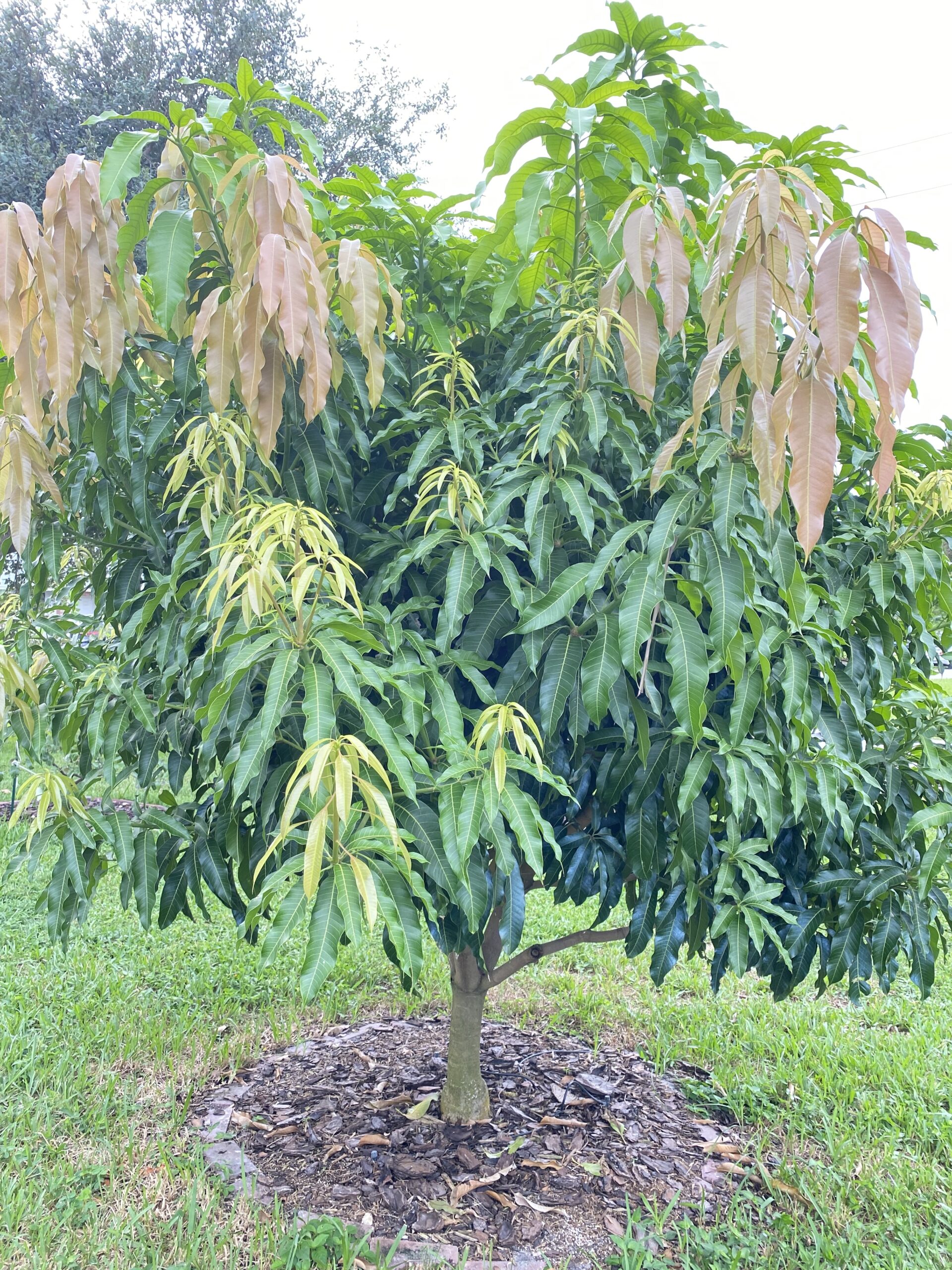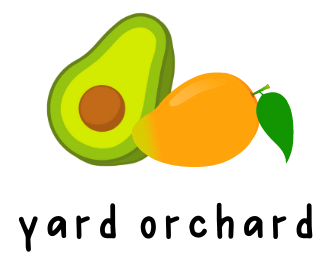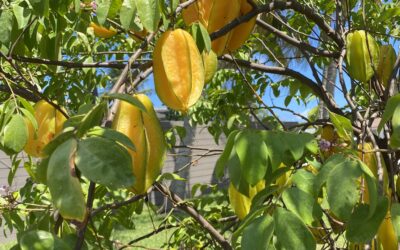
The Best Mango Trees to Grow in Florida
In Florida, if you live in Zone 10, Zone 11, or part of Zone 9b, you have to grow one or more mango trees. The mango trees are beautiful evergreen trees bearing delicious fruits. They are pest-resistant, requiring very little care. You might be wondering why I need to plant a mango tree since you can always buy them cheap at the local grocery store. Well, most of the mangos for sale there are Tommy Atkins mangoes. Compared to good mangoes, they are bland, tart, and fibrous. While the good mangos are sweet, and fibreless with intense and complex flavors. The differences are as day and night.
Once you decide to plant your own mango trees. Most likely you will be confused by so many varieties, and the list is still expanding. If you don’t select the varieties carefully, you might make some mistakes you won’t know until months even years later. In this article, I will show you the best mango cultivars to grow in Florida.
Three simple factors for mango cultivar selection.
****
1. The taste:
The flavor of mangoes can be quite complex, with notes of citrus, pine apple, peach, and coconut in some varieties. Mangoes can generally be categorized into five primary flavor profile groups:
- American (Mainly Florida) mangoes: Diverse flavors due to selective breeding.
- Southeast Asian mangoes: Light, sweet, citrusy, sometimes with a hint of coconut.
- Indian mangoes: Rich, sweet, intensely fruity.
- Mexican, Caribbean, Central American mangoes: Sweet, sour, slightly spicy.
- African and Australian mangoes: Mildly sweet with varying tartness.
Basically, I prefer fruits that are juicy, sweet, and fibreless. These are the mandatory requirements for a mango with good taste. On top of that, some tartness, i.e., a slightly sour or acidic taste will be balancing and make the fruits more enjoyable. American mangos, Southeast Asian, and Indian mangos have many good candidates.
2. The size:
Some mango varieties can grow quite large (up to 100 feet), while others are dwarf or semi-dwarf varieties that can be maintained at a smaller size (below 15 feet) by regular pruning without hindering fruit production. Normally for home gardening circumstances, the space is limited. The dwarf or semi-dwarf varieties are preferred. They are easier to manage, prune, and harvest due to their manageable stature. Dwarf and semi-dwarf trees often bear fruit earlier, provide a higher yield in smaller spaces, and are easier to protect from cold weather.
It is a frequent oversight for individuals to plant mango trees without taking into account their eventual size. Often, this mistake goes unnoticed until several years later, when a towering tree looms over the house, with fallen fruits cluttering the roof. Therefore, it is crucial to thoroughly study and understand the mature size of a mango tree before deciding to plant one.
3. The efforts:
I prefer the varieties which are disease-resistant, and require less maintenance.
These varieties are more likely to yield healthy, high-quality fruits and reduce the need for frequent interventions such as pesticide applications. They are particularly beneficial for beginners or those with limited gardening experience, offering a greater chance of success and a more sustainable approach by minimizing chemical use.
The best mango trees to grow
Pickering:
I consider the Pickering mango tree the best candidate for the first mango tree to plant due to its compact size, excellent flavor, precocity, disease resistance, and adaptivity to various growth zones. The tree is a workhorse for fruit production.
- Fruit Flavor: Pickering mangoes are very sweet with hints of coconut flavors, complemented by a smooth, buttery texture.
- Tree Size: The Pickering mango tree is a dwarf variety, making it suitable for smaller gardens and container cultivation. It typically reaches a height of about 8 to 10 feet.
- Disease Resistance: One of the notable attributes of the Pickering mango is its high resistance to anthracnose, powdery mildew, and bacterial black spot.
- Growth Zone: It is typically suitable for USDA hardiness zones 9 through 11. Some gardeners have reported success in zone 8b with proper protection during colder periods.
- Fruiting Season: Mid-season. It typically begins producing fruit in early to mid-summer.
Nam Doc Mai:
Nam Doc Mai is the most popular variety of mango in Thailand. The ivory mango very popular in China is in fact Nam Doc Mai. It is known for its exceptional sweet flavor, smooth texture, thin seed, strong aroma, long shelf life, high productivity, and disease resistance. The tree has a very nice horizontal growth habit as per my observation. It even branches nicely without pruning.
- Fruit Flavor: Nam Doc Mai mangoes are highly sought after for their exquisite flavor. They offer a unique combination of sweetness, rich aroma, and tropical notes, creating a delightful taste experience. The flesh is smooth, fibreless, and has a buttery texture, enhancing the overall enjoyment.
- Tree Size: Nam Doc Mai mango trees are typically medium-sized. While not a true dwarf, this Southeast Asian cultivar can be maintained as a smaller 8-10 feet tree with proper pruning and still have normal fruit yield.
- Disease Resistance: Nam Doc Mai mango trees have shown good resistance to diseases such as anthracnose and powdery mildew.
- Growth Zone: They are well-suited for USDA hardiness zones 10 to 11, which include areas with warm climates. They can also be grown in protected microclimates or with additional care in zones 9b.
- Fruiting Season: Mid-season. The Nam Doc Mai mango typically produces fruit from June to July.
Mallika:
This is a semi-dwarf, Indian cultivar that produces highly flavorful, fibreless fruit. It also has good disease resistance.
Mallika mango is considered one of the best varieties due to its exceptional flavor, disease resistance, compact size, and high productivity.
- Fruit Flavor: Mallika mangoes offer a delightful flavor profile. They are known for their excellent balance of sweetness and tartness, complemented by tropical and citrus notes. The flesh is smooth, fibreless, and offers a pleasurable eating experience.
- Tree Size: Mallika mango tree is small to medium sized, and can be maintained around 10-15 feet tall.
- Disease Resistance: Mallika mango trees demonstrate good resistance to common mango diseases, such as anthracnose and powdery mildew.
- Growth Zone: Mallika mangoes thrive in tropical and subtropical regions. They are well-suited for USDA hardiness zones 10 to 11, which encompass areas with warm climates. However, they can also be grown in protected microclimates or with additional care in zones 9b.
- Fruiting Season: Mid-season. Mallika mangoes typically offer a harvest from June to July.
Rosigold:
While not a true dwarf, it’s a smaller mango tree that produces sweet, virtually fibreless fruit early in the season. Rosigold has a good disease-resistance profile.
I like Rosigold mango due to its exceptional flavor, disease resistance, compact size, and adaptability. The Rosigold mango tree is known for its ability to produce fruits early in the season, providing an opportunity to enjoy fresh mangoes earlier in the year.
- Fruit Flavor: Rosigold mangoes are highly regarded for their delightful flavor. They offer a harmonious blend of sweetness, rich aroma, and tropical notes. The flesh is smooth, fibreless, and provides a luscious, melt-in-your-mouth experience.
- Tree Size: Rosigold mango trees have a relatively compact size, making them suitable for smaller gardens, container cultivation, or areas with limited space. They typically reach a height of around 10 to 15 feet.
- Disease Resistance: Rosigold mango trees demonstrate good resistance to common mango diseases, including anthracnose and powdery mildew.
- Growth Zone: Rosigold mangoes thrive in tropical and subtropical regions, typically within USDA hardiness zones 10 to 11. However, with proper care and protection, they can also be cultivated in slightly cooler zones such as 9b.
- Fruiting Season: Early-season. The Rosigold mango produces fruit from March to April, providing an opportunity for an early harvest. Sometimes they can fruit second time from May to July.
Neelum:
This is a dwarf variety that yields sweet, fibreless fruit and shows a good amount of resistance to disease.
Neelam mango tree is also one of my favorites due to its exceptional flavor, disease resistance, productivity, adaptability, and versatility.
- Fruit Flavor: Neelam mangoes are renowned for their exceptional flavor. They offer a sweet and rich taste with a pleasant aroma. The flesh is fibreless, smooth, and succulent, providing a delightful eating experience.
- Tree Size: The Neelum Mango is a dwarf variety with low-spreading and dense growth habit. They can easily be kept under 10 feet tall.
- Disease Resistance: It has high resistance to fungal diseases but susceptible to Anthracnose.
- Growth Zone: Neelam mangoes thrive in tropical and subtropical regions and are well-suited for USDA hardiness zones 10 to 11.
- Fruiting Season: Late-season. Neelam mangoes typically have a mid to late fruiting season. The fruits are ripe between July to September, and some even in October.
Coconut cream:
If you are looking for a nice-looking mango tree and like the coconut cream flavor, you must choose this variety. Coconut Cream mango tree is the favorite of many mango lovers due to its exceptional flavor, creamy texture, disease resistance, adaptability, and productivity.
- Fruit Flavor: Coconut Cream mangoes are known for their exceptional flavor profile. They offer a unique blend of sweetness with rich coconut undertones, creating a delightful tropical taste experience. The flesh is smooth, fibreless, and has a creamy texture, enhancing the overall enjoyment.
- Tree Size: Coconut Cream mango tree is a semi-dwarf variety. The tree can be kept between 10-15 feet with pruning.
- Disease Resistance: Coconut Cream mango trees exhibit good resistance to common mango diseases, including anthracnose and powdery mildew.
- Growth Zone: Coconut Cream mangoes thrive in tropical and subtropical regions and are well-suited for USDA hardiness zones 10 to 11. However, with proper care and protection, they can also be cultivated in slightly cooler zones such as 9b.
- Fruiting Season: Mid-season. Coconut cream mangoes ripen from June to July.
Carrie:
Carrie has been a very popular mango variety for 80 years due to its exceptional flavor, disease resistance, compact size, adaptability, and early fruiting.
- Fruit Flavor: Carrie mangoes are highly regarded for their exquisite flavor. They offer a sweet and rich taste with a perfect balance of acidity, creating a delightful eating experience. The flesh is smooth, fibreless, and has a buttery texture, enhancing the overall enjoyment.
- Tree Size: Carrie mango tree is a semi-dwarf mango variety, which can be maintained at a height of around 8 to 12 feet. They are considered a compact mango variety, making them suitable for smaller gardens, container cultivation, or areas with limited space.
- Disease Resistance: Carrie mango trees demonstrate good resistance to common mango diseases, including anthracnose and powdery mildew.
- Growth Zone: Carrie mangoes thrive in tropical and subtropical regions and are suitable for USDA hardiness zones 10 to 11. However, with proper care and protection, they can also be cultivated in slightly cooler zones such as 9b.
- Fruiting Season: Mid season from June to July.
Maha Chanok:
The Maha Chanok mango tree is revered for its unmatched flavor, disease resistance, productivity, adaptability, and cultural significance. The Maha Chanok mango fruits are visually stunning, exhibiting a beautiful combination of colors, with a vibrant golden-yellow skin that is often tinged with shades of red or orange. The fruit is typically elongated and slender.
- Fruit Flavor: Maha Chanok mangoes offer a remarkable flavor profile. They possess a unique blend of sweetness and tanginess, with tropical undertones that create a delightful taste experience. The flesh is firm, fibreless, and provides a satisfying texture.
- Tree Size: Maha Chanok mango trees typically have a medium size, It can be kept at a height of around 15 to 20 feet with yearly pruning.
- Disease Resistance: Maha Chanok mango trees demonstrate good resistance to common mango diseases, contributing to the overall health and productivity of the tree. This resistance reduces the need for extensive disease management.
- Growth Zone: Maha Chanok mangoes thrive in tropical and subtropical regions, typically within USDA hardiness zones 10 to 11. However, with proper care and protection, they can also be cultivated in slightly cooler zones such as 9b.
- Fruiting Season: The Maha Chanok mango tree is mid-season with fruits ripening from June to July.
Sweet Tart:
The Sweet Tart mango is a relatively new and unique mango cultivar known for its distinctive flavor profile, combining intense sweet and tart notes. Sweet Tart mango tree is also highly disease resistant. These features set it apart from the others. The Sweet Tart mango variety has gained more and more popularity and is ranked the highest by many mango planters.
- Fruit Flavor: The Sweet Tart mango variety is known for its distinctive flavor profile. It offers a delightful combination of sweetness and tartness, providing a refreshing and tangy taste experience. The flesh is smooth, fibreless, and delivers a zesty flavor that sets it apart from other mango varieties.
- Tree Size: Sweet Tart mango trees generally have a moderate size. It can be maintained at a height of around 10-15 feet with active pruning.
- Disease Resistance: Sweet Tart mango trees are highly resistant to common mango diseases.
- Growth Zone: Sweet Tart mangoes thrive in tropical and subtropical regions, typically within USDA hardiness zones 10 to 11. However, with proper care and protection, they can also be cultivated in slightly cooler zones such as 9b.
- Fruiting Season: The Sweet Tart is a mid-season mango (June – July).
PPK/Lemon Meringue (awesome citrus taste):
The Lemon Meringue mango tree shines with its exceptional flavor, disease resistance, productivity, adaptability, and striking beauty. Lemon Meringue and Sweet Tart mango varieties offer distinct flavor profiles, with Lemon Meringue combining sweet mangoes with subtle citrus notes, while Sweet Tart blends sweetness and tartness.
- Fruit Flavor: Lemon Meringue mangoes offer a unique and delightful flavor profile. They combine the sweetness of tropical mangoes with subtle citrus notes reminiscent of lemon. The result is a refreshing and tangy taste experience that sets it apart from other mango varieties. The flesh is smooth, fibreless, and provides a buttery texture, enhancing the overall eating experience.
- Tree Size: Lemon Meringue mango trees generally have a moderate size, typically reaching a height of around 30 to 40 feet (9 to 12 meters). This makes them suitable for larger gardens or orchards, where they can develop a robust canopy.
- Disease Resistance: Lemon Meringue mango trees demonstrate good resistance to common mango diseases such as anthracnose.
- Growth Zone: Lemon Meringue mangoes are adaptable to different growth zones. They thrive in tropical and subtropical regions, typically within USDA hardiness zones 10 to 11. However, with proper care and protection, they can also be cultivated in slightly cooler zones such as 9b.
- Fruiting Season: Early-season from May to June.
Lemon Zest (Highly rated but not disease resistant):
The Lemon Zest mango tree is celebrated for its exceptional flavor, combining sweet and tangy notes, which many consider to be the tastiest among mango varieties.
- Fruit Flavor: Lemon Zest mangoes offer a distinctive flavor profile that combines sweetness with tanginess. They provide a burst of tropical sweetness followed by a zesty kick, creating a tantalizing taste experience that sets them apart from other mango varieties.
- Tree Size: Lemon Zest mango trees generally have a moderate size, reaching a height of around 30 to 40 feet. This makes them suitable for larger gardens or orchards, where they can develop a robust canopy.
- Disease Resistance: Lemon Zest mango trees are very susceptible to common mango diseases, such as black spot, anthracnose, and powdery mildew.
- Growth Zone: Lemon Zest mangoes thrive in tropical and subtropical regions, typically within USDA hardiness zones 10 to 11. With proper care, they can also be cultivated in slightly cooler zones such as 9b.
- Fruiting Season: Mid-late season from July to Aug.
In conclusion, mango trees can thrive in neglect and produce tropical fruits known for their vibrant colors, juicy flesh, and sweet, tropical flavor. To select the best mango varieties for your home garden and ensure success, consider these steps. First, Consider the size and growth habits of different mango varieties. If you have limited space, look for compact or condo-sized varieties that are suitable for container gardening or smaller yards. However, even though they exhibit smaller growth habits and are more manageable in size compared to standard varieties. These condo-sized mango trees can reach heights of around 6 to 10 feet They still require proper care, pruning, and regular maintenance to control their size and ensure healthy growth. Second, Consider your flavor preferences when selecting mango varieties. Some are sweeter, while others have a more tangy or unique taste. Third, check for disease resistance in the varieties you are interested in. Opting for disease-resistant varieties reduces the risk of common mango diseases and simplifies maintenance. Fourth, determine the suitability of mango varieties for your climate. Research which varieties thrive in your region’s temperature and humidity conditions. Seek recommendations from local nurseries, horticulturists, or experienced mango growers. They can provide insights into varieties that perform well in your area. Finally, ensure you obtain mango trees from reputable sources, and follow proper planting and care guidelines. Provide appropriate sunlight, water, and nutrition while monitoring for pests and diseases. By following these steps, you’re primed to make an informed decision on the most suitable mango varieties for your home garden and substantially increase the likelihood of a successful harvest.



0 Comments